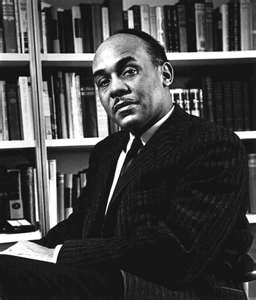 |
| The American Academy, Rome. This McKim, Mead & White building is on Itinerary 1 of Rome the Second Time - pp.37-37 of the print version. |
 |
| Ralph Ellison, probably 1952 |
 |
| Ralph, outside his study at the Academy |
 |
| Ralph at the Academy |
Rome was no solace. Indeed, Ralph for the most part avoided the city, venturing down the hill mainly to enjoy the Porta Portese market, where he purchased (what he thought were, and may have been) genuine Etruscan objects. During a second year (yes, he disliked the place so much that he applied for an extension of his fellowship) he seems to have enjoyed driving a Volkswagen, loaned him by a publisher, in Rome's then-tolerable traffic, though Fanny described Roman drivers as "wild and crazy," adding that Ralph "loses his temper very quickly." For the most part, however, Ralph simply ignored the Rome. He knew no Italian and took no lessons. Although he had been told of a small black district in the city, he made no effort to find it. And rather than visit an Italian barber, he cut his own hair. "Ralph walks a narrow path," wrote Fanny, "from our living quarters to his study and back." (For a very different reaction to spending time at the Academy, and to Rome, see our post on Michael Graves in Rome.)
Fanny was more receptive to the world outside the Academy. In words that reflected how different from Ralph's was her perception of the city, she wrote, "We, I, love this wonderful city; its wonders are endless." Writing to a black friend eager to come to Rome but concerned about how she might be received as a person of color, Fanny counseled: "I believe you would like the Italians; they're very much like Negroes...informal, voluble, warm."
Ralph longed for life in Harlem. "I'm homesick," he wrote, "for moses [blacks] for one thing." He was homesick, too, for the cultural environment of New York City. "This place," he wrote of Rome, "has little of the creative tension so typical of New York. You can see more art, hear more and better rendered music, and heaven help us, find more interesting writing, there in a day than you can in months here." In one letter, he described Rome as "a rather provincial town." While there is some truth in Ralph's judgment, it is also apparent that he failed to explore what the city had to offer. Rome's most important post-war writer, Pier Paolo Pasolini, was living just a mile from the Academy, on one of the spurs of the Gianicolo. He had moved there, onto Via Fonteiana, in 1954, and in April 1955--just months before Ralph arrived--published his first novel, I Ragazzi di Vita.
Ralph made only minimal progress on his second novel during his 26 months in Rome, but the Academy--and the city--did provide friendships and some of the intellectual stimulation he required, especially in his second year. He saw a lot of fellow novelist (and New Yorker short story writer) John Cheever, who was living in Rome, and he formed deep friendships with John Ciardi and Robert Penn Warren, both at the Academy in 1956/57. Others who were Academy fellows or visitors during Ralph's tenure included Allen Tate, Robert Venturi, Alexander Calder, Ben Shahn, Helen Frankenthaler, Archibald MacLeish, and Ignazio Silone. On one of his excursions outside the academy walls, he had unexpectedly encountered historian Arthur Schlesinger, Jr., on the Spanish Steps. "Aren't you Arthur Schlesinger?" Ralph asked? "Aren't you Ralph Ellison?" Schlesinger replied.
There was a pleasure of another sort. Ralph had an affair in Rome. She was young, white, attractive, married, part of the city's American community, a regular visitor to the Academy. They made love in Ralph's study and for several months imagined a life together. Fanny knew, and she knew that others knew, and she understandably withdrew from the Academy round of life, then returned to the States, alone. Ralph followed in November 1957, and eventually they put their marriage back together.
-----------------------------------------------------------------------------------------------------
This account is adapted from Arnold Rampersad's excellent treatment, Ralph Ellison: a Biography (Vintage, 2008), available in print and electronic versions at amazon.com. Highly recommended.
Bill







